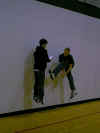 IB Physics I Home Page | Go up
IB Physics I Home Page | Go up
Topics |
Photos |
Document and Lectures
(From Documents and Lectures use the "Back" Button to
return here)
IB Physics I
Prerequisites: Chemistry, Algebra II (Must) Concurrent enrollment in Precalculus
is
recommended.
This is a fast-paced course that is the first of a two year IB Physics
sequence preparatory to the higher or standard level IB physics examination,
and the AP B test in physics (with some outside preparation) The first year
(IB Physics I) will prepare students for the AP C test (in mechanics only)
if taken concurrently with Calculus.
IB Physics I covers all of mechanics (Linear motion, Projectile motion,
Dynamics, Energy, Momentum, Gravity and circular motion,
and Statics) and waves and thermal. There is an emphasis
on problem solving, numerical manipulation, and laboratory skills. Non-IB
students are welcome, but they must be willing to keep pace with the IB
syllabus. There is a required field trip near the end of the year to Oaks
Amusement Park.
Topics .:. Up
Chapter 2 - Linear Kinematics
The first unit covers motion in a straight line. We first look at a constant
velocity, and then go on to uniform acceleration. We do labs on describing
motion, determining uncertainty, making graphs of motion both with timer
tape and computer rangefinders.
Chapter 3 - Vectors and 2-Dimensional Motion
In this chapter we look at how to resolve, add, and multiply vectors. Then
we use these skills to solve two dimensional motion problems as two independent
linear problems. We will do a computer lab and a rocket competition.
Chapter 4 and 9- Dynamics and statics
This is the first chapter of real physics. We will study Newton's laws,
and apply them to calculate the acceleration of an object with many different
forces acting it. We will do extensive problems with inclined planes, friction
and pulleys, and statics. The laboratory is about the force of friction.
Chapter 5 - Gravity and Circular motion
We will study centripetal acceleration and force, and relate them to friction,
Newton's second law, and the Force of gravity. The laboratory involves a
simulation of orbital mechanics..
Chapter 6 - Energy
We will use energy and conservation of energy to make otherwise difficult
problems solvable. Students will design a lab to measure human power.
Chapter 7 - Momentum
We will study and solve collision problems using conservation of momentum.
We will become rocket scientists, blow things up, and make loud exploding
noises in the hall and in the classroom.
Topic 4 - Waves (Chapter 11, 12)
We will study the principles of wave mechanics, standing waves, sound,
resonance, simple harmonic motion, reflections, refraction, polarization,
music, bat echolocation, and untertones. Students will measure the
speed of sound.
Topic 3 - Thermodynamics (Chapter 13, 14,
15)
This covers Chapters 13, 14, and 15. Topics include the ideal gas law,
linear expansion heat, specific heat, latent heat, phase changes, entropy,
heat engines, and the laws of thermodynamics. We do a lab on absolute zero
and one on Newton's law of cooling and exponential functions.
Photos .:. Top
(Click on thumbnails to see photo, use "Back" to
return here)









